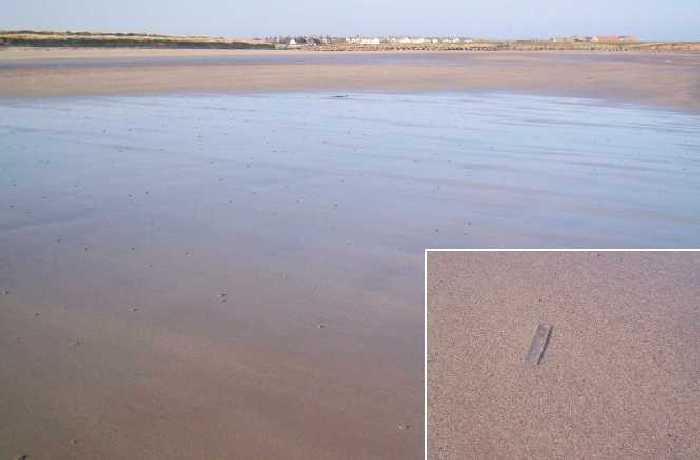
That's a six-inch (15 cm) ruler in the close-up inset, by the way. It features in lots of these photos.
Sands are great for the kids of course. Those wide open spaces with shallow waves are ideal for the dogs. And it's all far enough away from civilisation (if you've left your mobile in the car) to make for total relaxation.
But sands aren't boring ! There are patterns everywhere, some easily explained but others totally mysterious. A first assumption is, usually, that sand is - well, it's just plain SAND, isn't it? Like this on south beach -

That's a six-inch (15 cm) ruler in the close-up inset, by the way. It features in lots of these photos.
But if that were all there was to it you wouldn't have the patchiness of wet and dry, plain and ridged, light and dark, with and without worm casts.
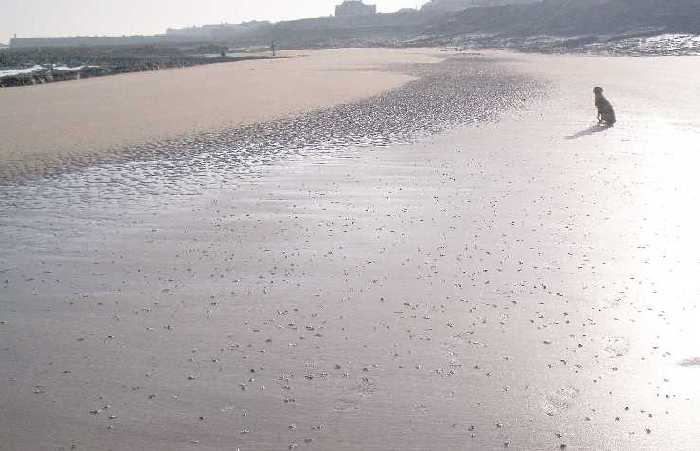
This is actually on Seahouses' north beach but the same happens -
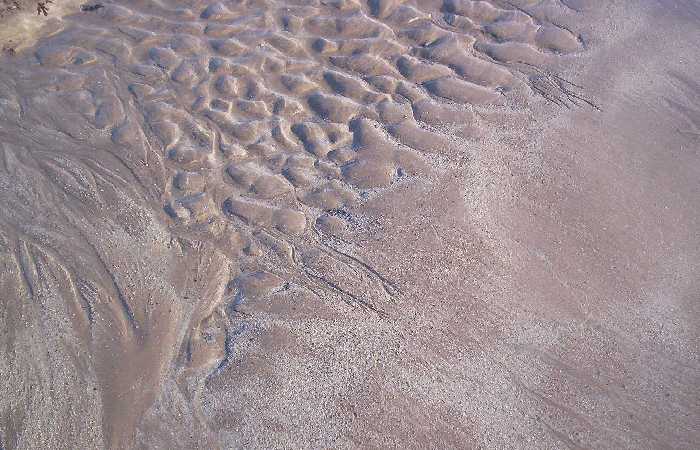
- on south beach, seen here more in close-up.
There are areas of different colours, of different textures too, as here down towards Beadnell.
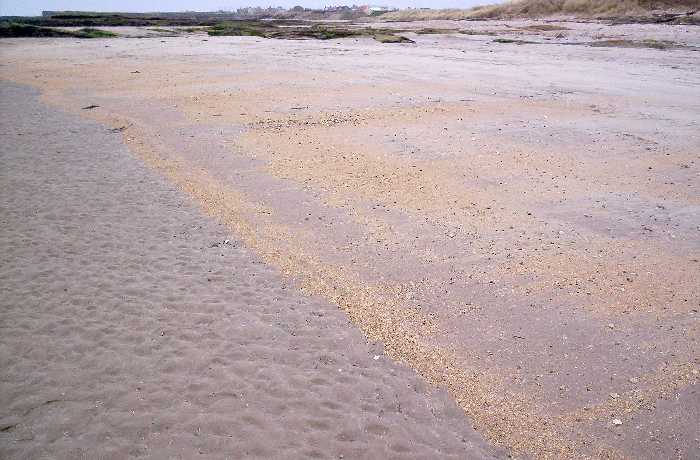
It seems impossible to work out why each pattern or lack of pattern is where it is. What's different across the otherwise invisible boundary? Will it be the same after the next tide? Will it even be the same at the end of the week?
Fortunately, some patterns can easily be accounted for. Raindrops speckle the sand, but the incoming tide smooths the surface once again.
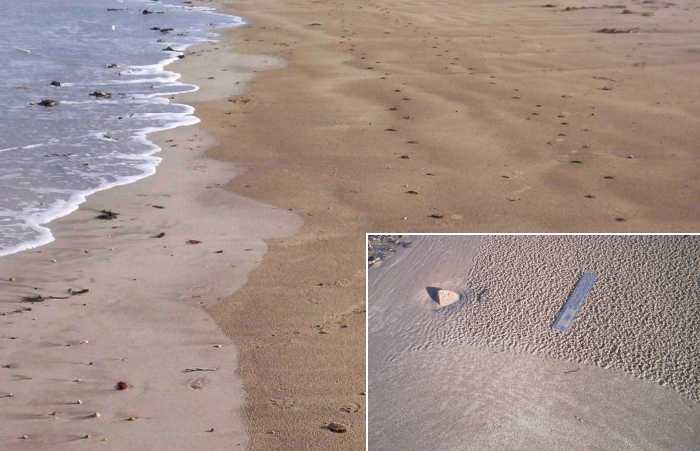
A beach has lots of water movements in and through the sand quite apart from the coming and going of the tides. In many patches the water - it may be fresh water percolating underground from in-land - this fresh or salt water can't drain down through the beach sand so it stays on the surface as in the first photo. More than that, if water IS moving across and having to drain out to the surface there has to be what inland would be called a 'spring line'. Water oozes out at many points, joining up to form miniature drainage channels in tree-like, dendritic, patterns.
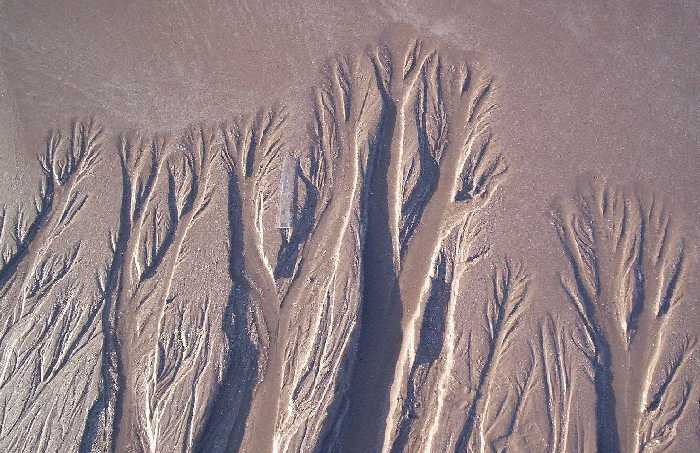
Yes, the ruler's there, near the centre.
These movements of water through the sand must have something to do with denseness or permeability or some such. The effect can be reversed, with a flow of surface water going back down into the sand: the pattern it produces is very similar to the spring-line case. In fact where there is a very local underground blockage water can come up and then go down again, producing a double-ended tree pattern !
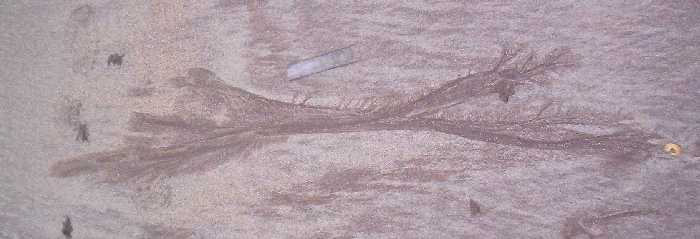
The down-slope water flow was from right to left.
Where a more major 'spring' occurs greater amounts of sand are carried. If the water then soaks back down the sand accumulates as a mini-sandbank.
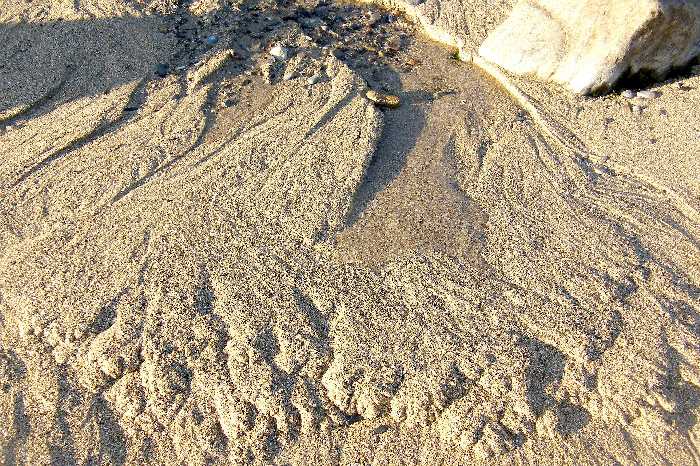
In fact the ideal site for the most imaginative sandcastles is where water is draining across the sand. The 'rivers' have their own patterns of standing waves: the 'island' sites have their own moats.
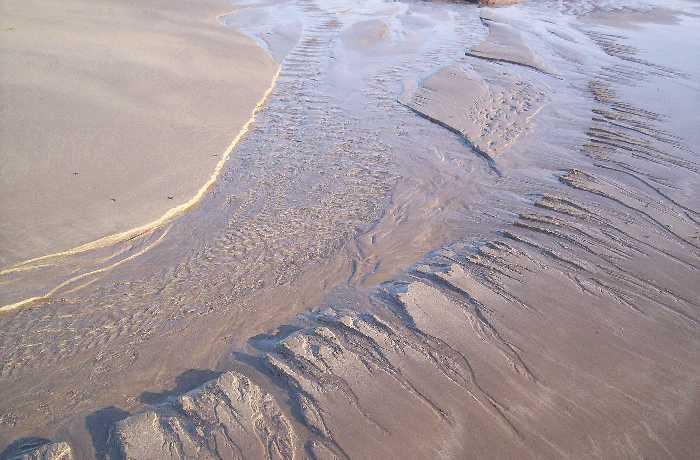
But the mystery formations are all those ridges. Why are they there - in some places and not in others? The first thought may be that they're caused by the water flows. That seems obvious along the side of the Annstead Burn behind south beach, where the ridges are clearly at right angles to the water flow.
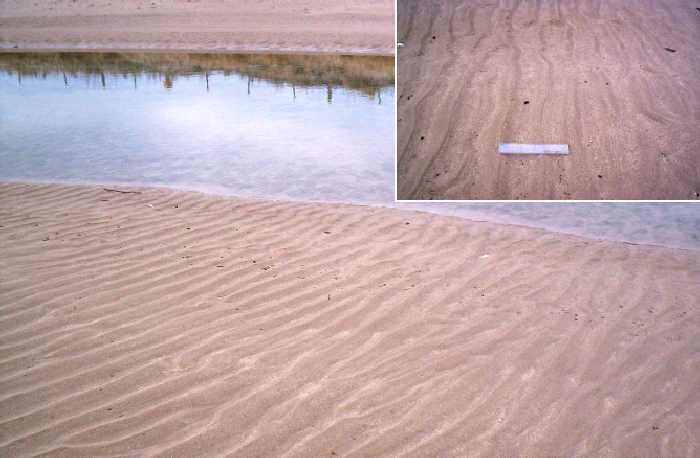
So that would explain lots of regular sea ridging too.
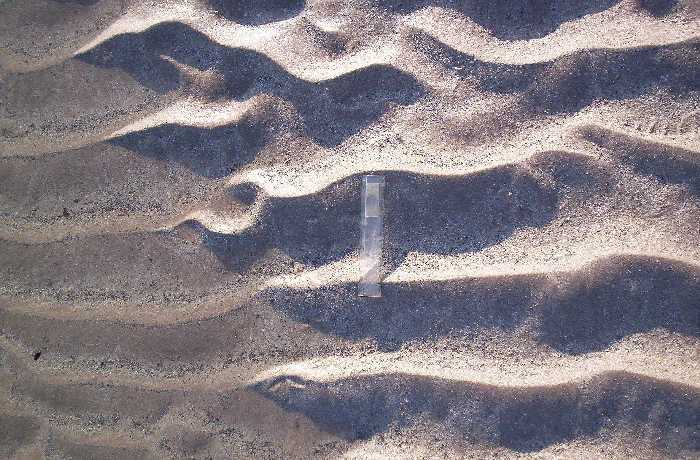
The ridges persist when exposed to the air and under water in pools. But they are easily destroyed by water flowing across the sands.
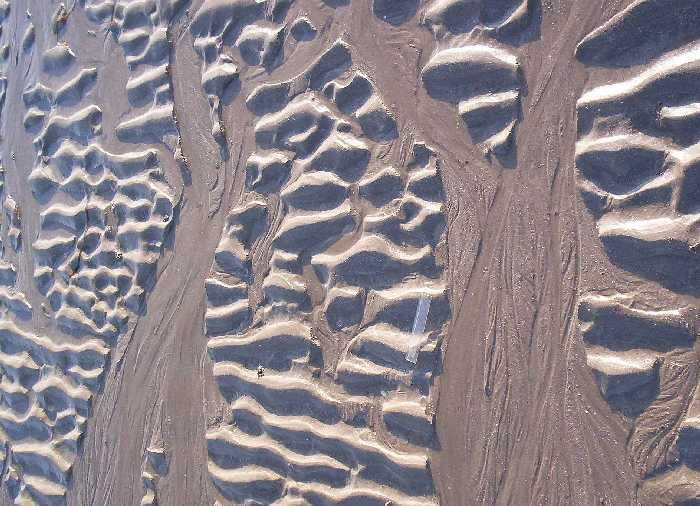
So it seems that the ridges must form under water during the high-water phases of the tide. But if it's the sea wave movements that are responsible why are they not more regular? We can find different 'wavelengths' right next to each other -
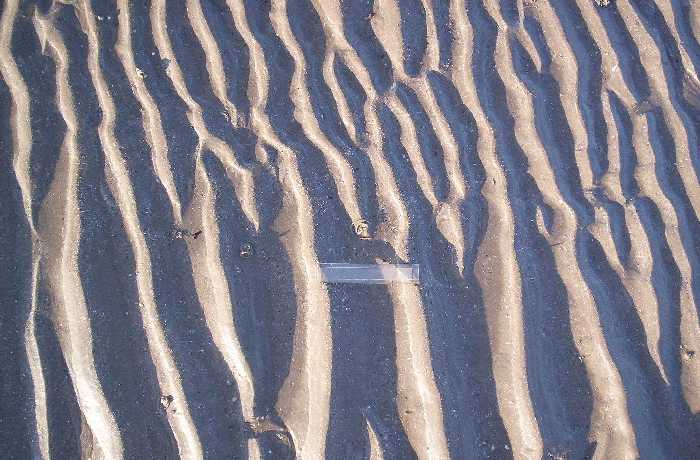
One thing is certain - ridging does not depend on there being a goodly depth of sand. The next photo is of modest amounts of sand carried across solid rock (and a large flat pebble). Ridging occurs here as elsewhere.
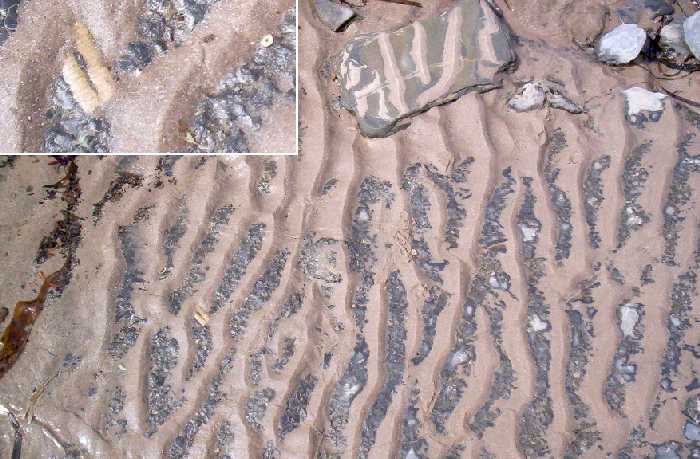
The inset enlargement shows that there are fossils in some of the local limestones.
We can find the tops of the ridges planed off flat -
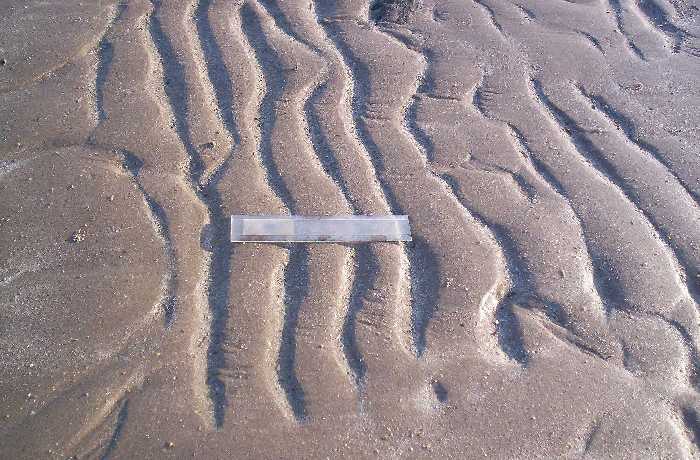
Instead of roughly parallel lines there are areas where the ridges run in all sorts of different directions.
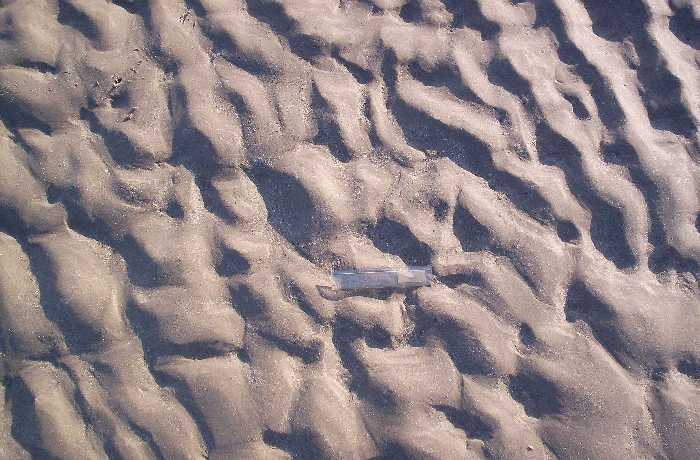
Even stranger perhaps, there are odd patches on which the ridges are ridged at right angles !
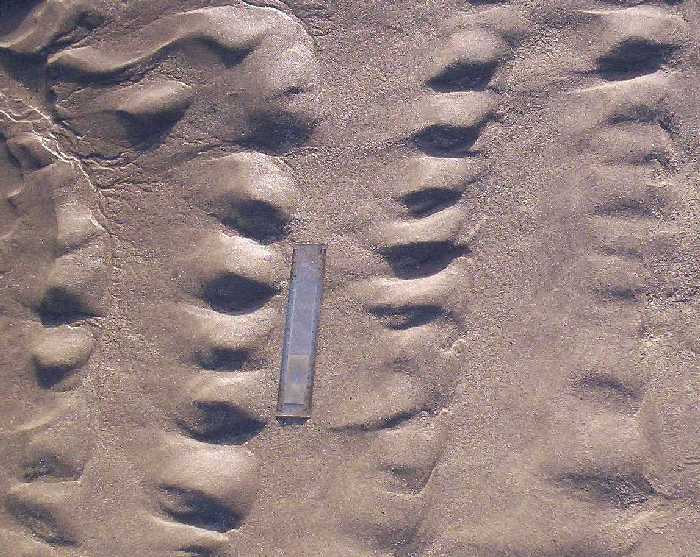
A herring-bone pattern appeared during a severe gale, blowing off-shore - top to bottom in the picture. The walking-stick type of litter-picker gives an idea of scale.
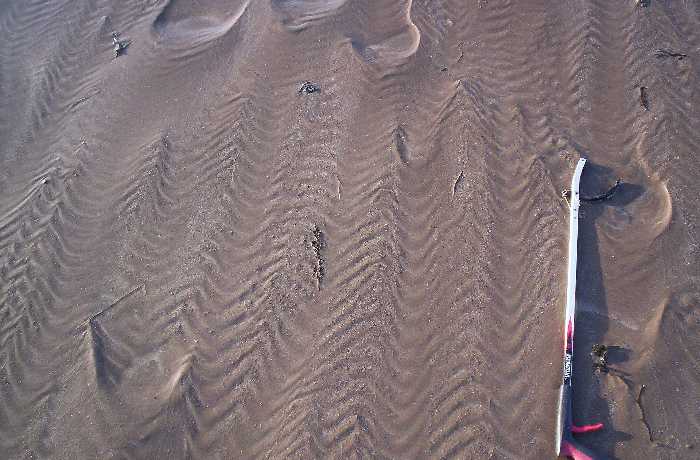
For no obvious reason, there are some occasions on fairly level areas where the sand is formed into a pretty random pattern of flat topped raised patches with depressions between. There may be some indication of ridging just in those depressions. Boffins tell us that all forms of fluid flow include so-called "chaotic" elements. It's not clear whether that is supposed to be an explanation or an excuse as to why no explanation is forthcoming !
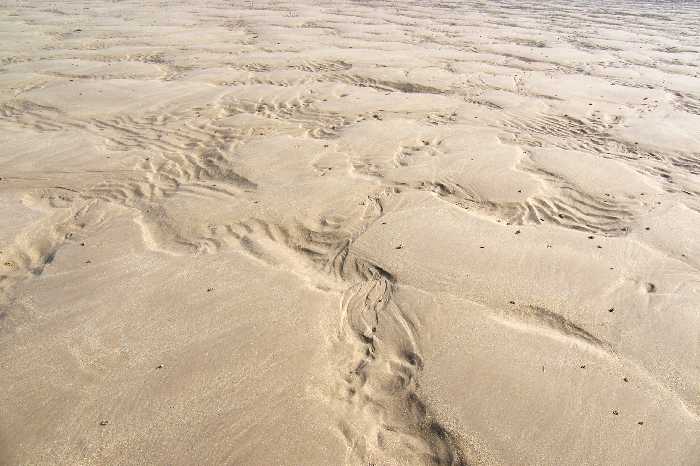
It may seem ironic, then, that when the ridges are almost undetectable they are more regular. Even when you and I can't see any unevenness the water movements grade the particles into bands which are often quite distinct.
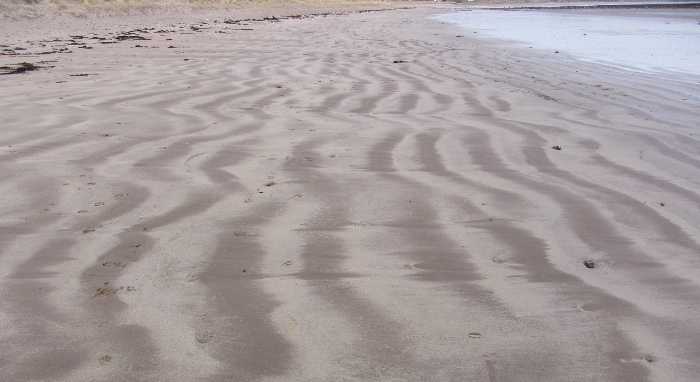

But don't imagine that's the effect of individual waves ! Oh no. Under suitable conditions each wave does, indeed, have a slight sorting effect along its up-shore edge which may possibly result in a faint line being left behind. But they aren't common and they're never straight. A bit of coal in the mixture (see the Seahouses Rocks page) does help to make them show up though.
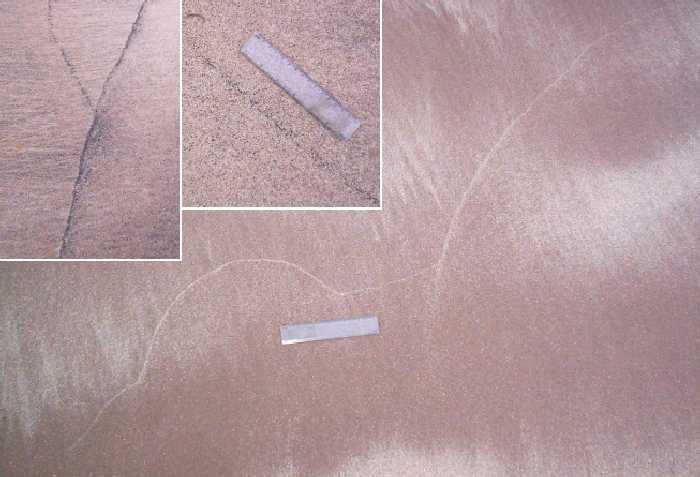
All final water movements are down-shore, of course - back towards the sea. But virtually anything can cause a slight diversion, usually resulting in a V-shaped pattern. Nothing very curious there !
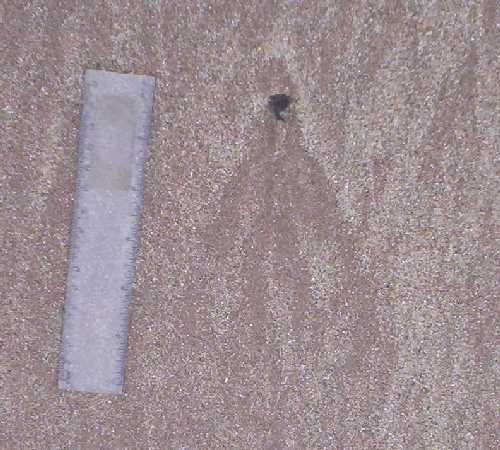
What IS strange is that under SOME (unidentifiable) circumstances the sand seems to imagine there is a network of ghost obstructions. So it produces a fairly regular series of overlapping V marks and the total result is a diamond pattern, sometimes emphasised through the presence of a bit of powdered coal.
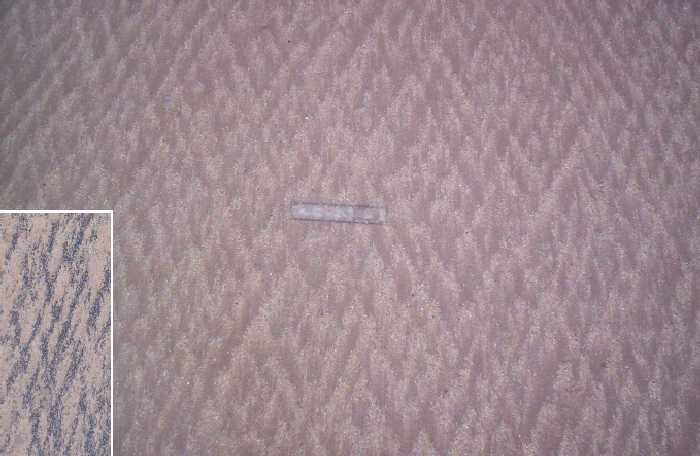
This is (relatively) commonly the case over quite large areas. But it can also occur, equally mysteriously, in a small patch.
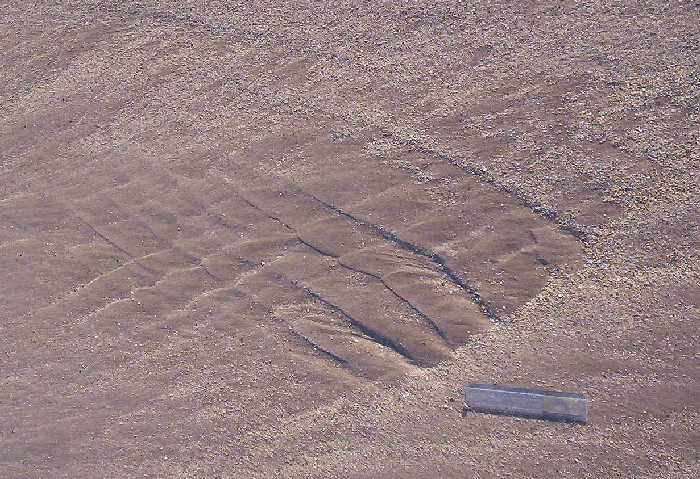
At all events, there are some other patterns which do seem to be a bit more reasonable. Like swirling, for example. Wave movements very commonly excavate a trench round any large, isolated fixed obstruction.
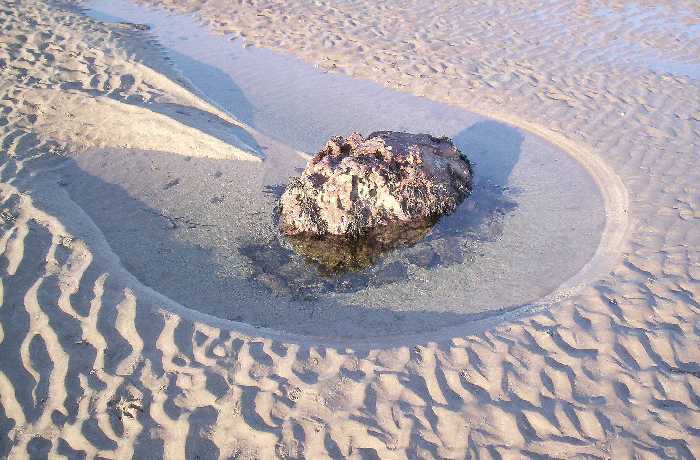
Much smaller - perhaps too small to be noticed - are tiny holes in wet or damp sand.

There's no authoritative explanation for such holes. One theory concerns air movements during a rising tide. As water swooshes across the top of the sand with each incoming wave any air trapped below the surface is displaced: bubbles may be visible, briefly. That movement forms each air pocket into a mini-fountain of sand, air and water. If that happens just before surface-water movement ceases then the erupted spoil-sand is washed away leaving a clean-edged hole, but otherwise the ring of displaced sand remains in place. If subsequent waves don't reach the same level those formations remain to intrigue us - until the next higher tide anyway.
But the sands are part of an ecosystem too. Tons of seaweed get washed up, especially each autumn. At almost any time of year lifting a handful of it reveals a running, jumping, leaping host of the sandy-coloured seaside version of woodlice.

These might be any of nine species of "sandhoppers": it takes a real expert (or another sandhopper) to tell them apart. Information is available by looking up details of the Talitridae family: Talitrus saltator occurs fairly commonly.
But they're never going to consume any significant proportion of the cast-up seaweed. Masses of even more minor bugs and micro-organisms set to and use it all as food, rotting it down, before and after burial brought about by sand movements. This produces gas as a byproduct, possibly smelly at times: it is thought that a proportion of the myriad of tiny holes per square metre often to be seen may be caused by this gas escaping to the atmosphere. Details seem to depend on the texture and moisture content of the sand. But under certain conditions in some places the gas gets trapped just below the surface of the sand and forms temporary modestly inflated pockets like this -
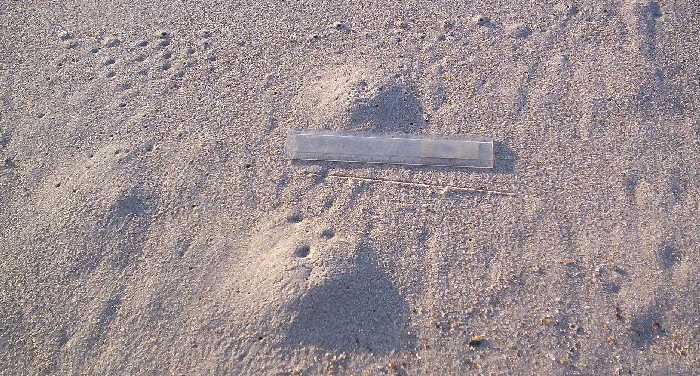
A different type of formation can be seen from time to time, usually above the currently wet sand but below the highest strandline. Its origin seems to be a complete mystery: it's not even clear whether it has a physical or a biological cause.
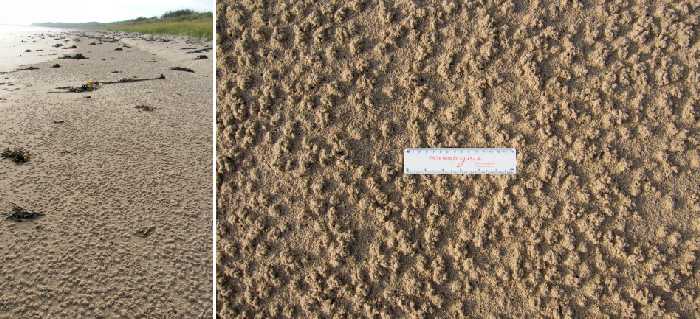
There's no evidence of shore birds or other predators taking any interest: perhaps they haven't sussed out what the cause is, either. What is certain is that these lumps don't have holes in their middles. By contrast, some bugs that do live in the sand make themselves burrows - the patient observer may even be lucky enough to see them doing it - heaving the spoil in a circle around the burrow entrance hole.
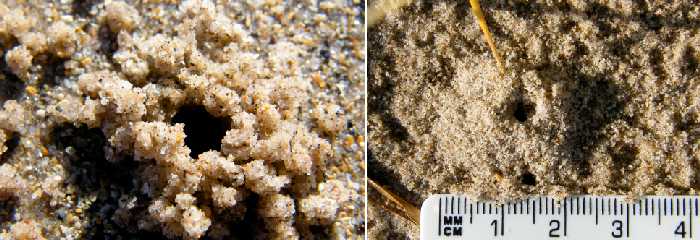
Be that as it may, probably the most obvious signs of there being life actually IN the sand is the presence (again only in some areas) of the casts produced by several different kinds of worms living in U-shaped burrows. Most of the time that's all there is to see, short of digging down six or ten inches to find the beastie responsible - usually the lugworm.
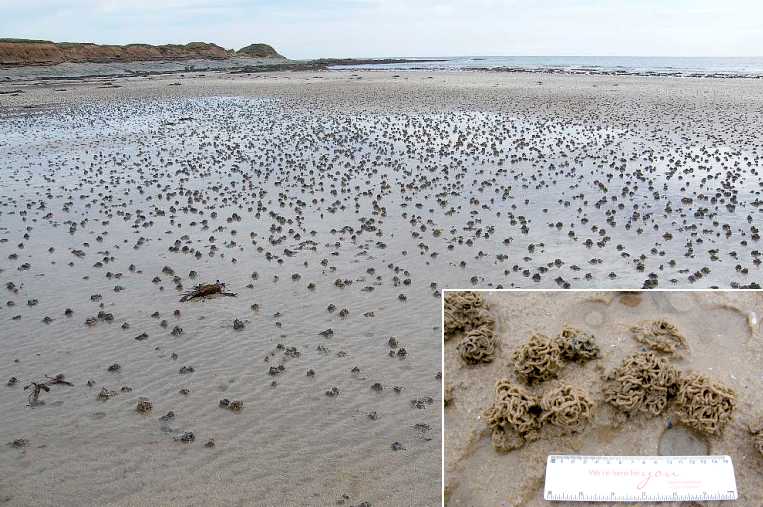
But occasionally, when sand and water conditions are just right, the intake end of the burrow can be seen as a cone-shaped recess. These chaps are no respecters of territorial limits, so it's only when the population is low that it's possible to relate a front-end depression to a tail-end cast with any degree of certainty.
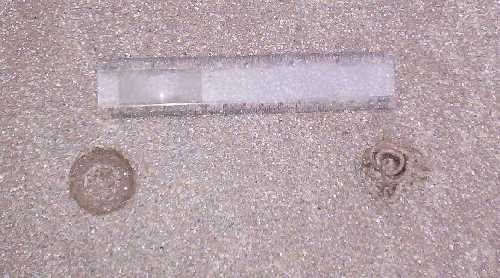
Those aren't the only holes in the beach. Less common but more characteristic are small holes which have a ridge or irregular raised rim round each one. This is the result of a long-beaked bird - probably an oyster-catcher or curlew - probing the sand to find its food items living in the sand.
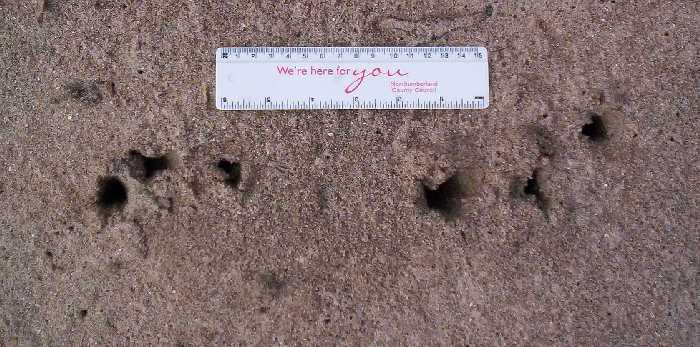
Rather less obvious are some mysterious line-makers. The answer to the mystery is clear only if you happen to catch one at it.
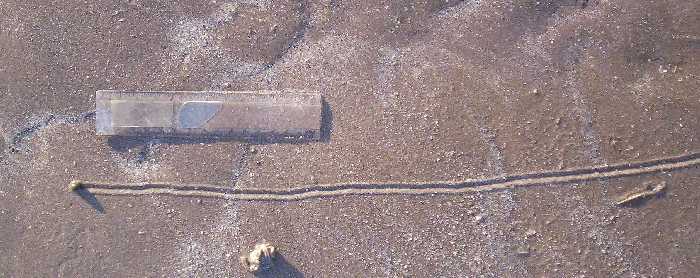
That's a small marine snail, possibly a periwinkle, belting along at millimetres per minute, grazing his microscopic nourishment from the surface of the sand.
It's probably not very far removed from an area of permanent resident seaweed.
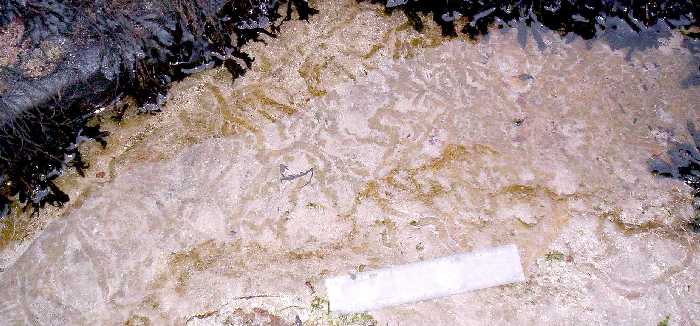
But its brethren seem never to stick to the straight and narrow.
Perhaps it wasn't an animal at all?
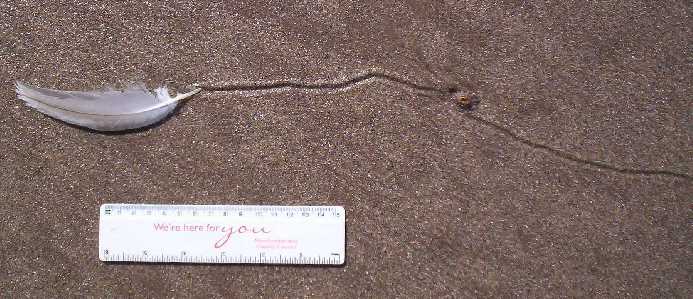
But there are also, in some local areas under some moist or wet conditions, patterns of much finer tracks, more difficult to spot. These must be made by the smaller, virtually invisible worm- or maggot-like inhabitants of the sand. It is rare indeed to see the tracks being made and even more difficult to photograph the engineers at it!
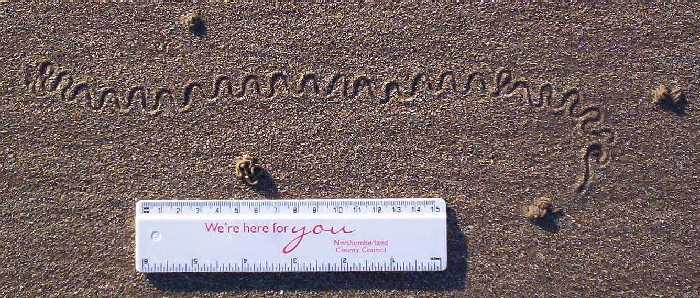
It's not always clear just what's going on. This wasn't even on Saint Valentine's day.
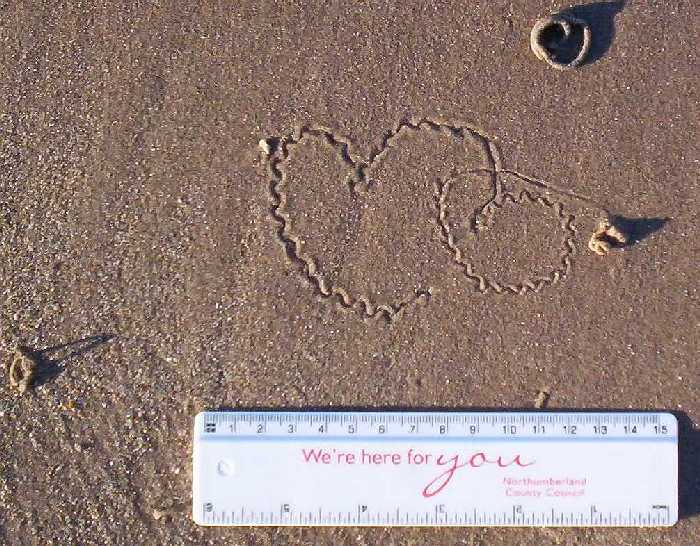
|
When lighting conditions are ideal it's possible to see that an ordinary patch of wet sand has evidently been a veritable Spaghetti Junction for its inhabitants since the last tidal smoothing. |
There is another biological aspect of seashore sands, arising from the fact that all seaweeds have lifespans limited, usually, to a few years. When they die huge tonnages of them can be washed up and stranded on top of the sands, particularly in the autumn.
 But as the sands are moved around by winds and tides it is often the case that all that organic material is partly or wholly buried: it is then broken down by micro-organisms. But if that is the case the sand must have been removed from somewhere else. The right-hand picture shows where the washing away of sand has left a veritable sand cliff, destined to collapse either by inundation or by drying out.
But as the sands are moved around by winds and tides it is often the case that all that organic material is partly or wholly buried: it is then broken down by micro-organisms. But if that is the case the sand must have been removed from somewhere else. The right-hand picture shows where the washing away of sand has left a veritable sand cliff, destined to collapse either by inundation or by drying out.
The usual interface between sands and vegetation occurs where dunes form, thanks initially to marram grass. That topic is explored in our Seahouses Dunes page: there's a link at the end of this page. But it is possible for a whole transient ecosystem to develop at times.
The highest high water springs tend to occur around the times of the equinoxes in March and September. So the top edge of a sandy shore may be unaffected by salt water for months during the interim. Nature always grabs every opportunity so it is not too surprising to find that noticeable vegetation can develop over the undisturbed summer months.
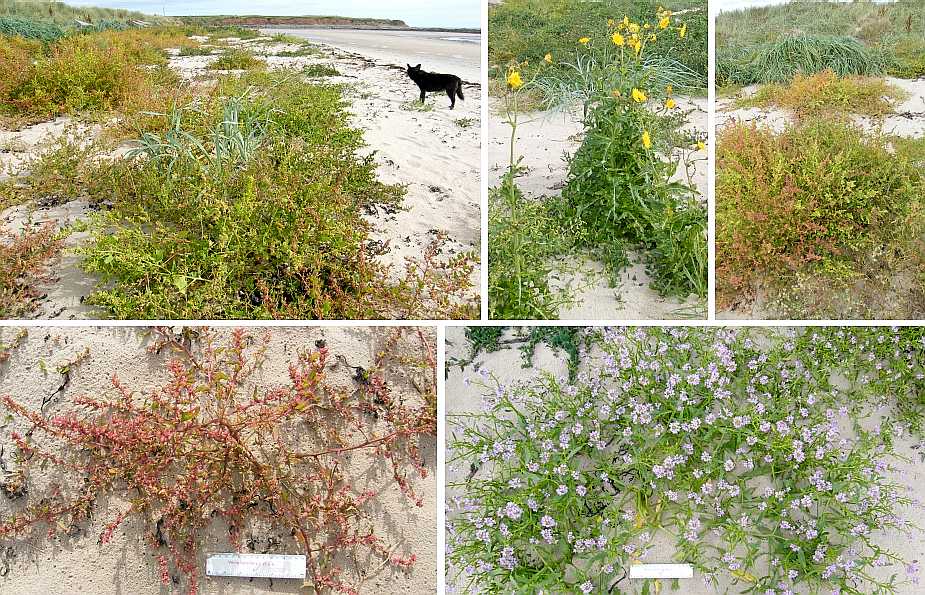 Plants must be quick-growing, to flower and seed within the available time-slot. Sea rocket (lower right) Cakile maritima qualifies with beauty as well, but the bulk of the material is of Atriplex and Chenopodium species. The less common yellow-flowered composite may be a sow thistle Sonchus oleraceus or close relative. Isolated marram grass plants may develop from seed or from fragments of underground rhizome, as well as providing a background where any new dunes are trying to develop.
Plants must be quick-growing, to flower and seed within the available time-slot. Sea rocket (lower right) Cakile maritima qualifies with beauty as well, but the bulk of the material is of Atriplex and Chenopodium species. The less common yellow-flowered composite may be a sow thistle Sonchus oleraceus or close relative. Isolated marram grass plants may develop from seed or from fragments of underground rhizome, as well as providing a background where any new dunes are trying to develop.
|
The end of that particular cycle happens as the first autumn storm attacks the accumulated sand and cast-up seaweed. |
A mystery appeared in the middle of Annstead beach, south of Seahouses, near the end of March 2012. In a wet, ridged section of the sands there were to be seen hundreds of what looked like tadpoles.

But frogs or newts and their tadpoles are never, but never to be found on sandy seashores. On closer inspection each 'tadpole' seemed to be a structureless blob with a sort of tail which was somehow anchored into the sand: there was certainly no sign of any movement or activity. What could they be? Extensive research produced an answer eventually. They were the egg-sacs of quite sizeable multi-legged (polychaete) 'worms' living in the sand and/or around nearby rocky pools (though there was no other obvious evidence of their presence). They delighted in the general name of Phyllodocida. There's information about the worms (but little about how they reproduce) on the Tree of Life website at http://tolweb.org/Phyllodocida.
So the beaches north and south of Seahouses, towards Bamburgh and Beadnell respectively, constitute permanent, ever-changing exhibitions of a variety of interests. All year round. We never close ! What you saw last week will be different this week, but the variety you witnessed last year will still be there next year too.
|
HOME page
Location
Routes
Street plan
Attractions
Visit
Photo album
Walks to/from Dunes Rocks Tidal Zonation Community Directory Trades Directory |